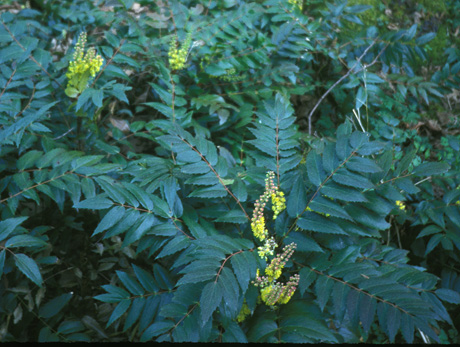Oregon Grape
|
| Woodlands in Seattle are carpeted mostly by three common
evergreen groundcovers: Sword fern, Salal and Oregon grape. They are so
abundant that everyone can easily become acquainted with them. If you can
tell pigeons, crows and robins, you can recognzise common wild shrubs,
too. Each of these three species can grow over acres, making lush colonies
of green. Actually the Oregon grape consists of two species, a low one
and tall one. Both bear holly-like leaves, yellow flowers and
powder-blue berries. |

|
Tall Oregon grape (above) is Oregon's state flower. It grows usually at
least waist-high, frequently 8 feet, and some in Seattle reach 12 feet. In
extreme age and good conditions it can attain 15 feet. The leaves consist of 5 to
13 glossy leaflets, each edged with sharp teeth like a holly. In spring
the shrub makes crowded clusters of bright yellow, minute flowers.
These are lovely and lightly scented. Then the brand new leaves shoot
forth, bronzy colored and tender at first, gradually becoming stiff and
prickly. In late summer or fall the berries ripen. Sometimes in winter the
leaves turn purplish. Tall Oregon grape is also called Shining Oregon grape,
and is known to most botanists as Berberis
aquifolium, to most horticulturists as Mahonia
aquifolium. (Neither name is exclusively correct; it is
a matter of whether a person adopts a narrower or broader judgement
in delineating genera and species.)
|

|
| Low Oregon grape (above), also called Dull Oregon grape and
Cascade Oregon grape, is Berberis or Mahonia
nervosa. It is usually only knee-high to waist-high, and its leaves are much longer, with 9 to 23 less
glossy leaflets. Its flowers appear later in April, in skinnier clusters, and
its berries ripen later. It is far more common in woods, while its tall
cousin is more common in open places. |
| Both species are useful to bees for their flowers, and to birds or
other animals for their berries. It is somewhat well known that humans can
use the berries to make jelly. However, the flowerbuds, flowers,
tender young leaves and immature berries are also edible raw, tasting sour
like sorrel. I prefer the flavor of the low-growing species. As for the
berries, eating them while green and young is more pleasing to me than
waiting until they turn blue, plump with purple juice. When fully ripe they
are exceedingly sour and seedy. By squeezing the juice from enough
berries I have made the world's most nutritious popsicles. |
The inner bark of the roots and stems is a distinctive bright yellow
from berberine, an alkaloid useful in herbal medicine for treating skin
problems, dysentery, sore throats, diarrhea, syphilis, cholera and
whatnot. Some people buy dried Oregon grape root pieces from herbal stores
to make their own medicines. Partly for its berberine content,
naturopathic physicians have long used Goldenseal
(Hydrastis canadensis; not a close cousin of Oregon grape). Use of any plant containing berberine
should be done in moderation, as excessive quantities may be harmful. There
is no evidence that nibbling Oregon grape flowers, flacid young leaves,
or berries is anything but delightul. Taste it and judge for yourself.
|
(originally published in The Seattle Weekly, April 1997)
Back |
|
|

